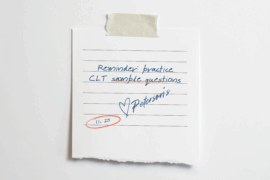The TOEFL test assesses your English language mastery and is especially important for undergraduate and graduate programs for non-native English speakers, as a sufficient TOEFL score can grant you admission. It is regarded as a challenging test for both non-native speakers and native speakers alike. Fret not, though; with proper test preparation, Peterson’s is confident you can confidently express yourself in English and reach your desired TOEFL score.
What is a TOEFL Test?
The TOEFL exam stands for Test of English as a Foreign Language, and its purpose is to assess your grasp of English for university entrance and beyond. There are different versions of the test:
- TOEFL iBT® test—assesses English level for university
- TOEFL ITP® tests—assesses English skills for academic success
- TOEFL Junior® tests—assesses younger students’ English skills with their future success in mind
- TOEFL Primary® tests—assesses students’ English skills at the beginning of their English acquisition and comprehension.
For this blog, we’ll be taking a closer look at the TOEFL iBT test and sections, as this test is the most popular among the suite of TOEFL tests. It’s widely accepted by universities and institutions worldwide, including top schools in the U.S., Canada, the U.K., Australia, and beyond. TOEFL iBT is a comprehensive, reliable measure of English language proficiency, and it assesses:
- Reading
- Listening
- Speaking
- Writing
It can be taken in person at official test centers or at home with the TOEFL iBT Home Edition, offering more flexibility. The iBT provides detailed score reports that help test-takers understand their strengths and areas for improvement. What is considered a good TOEFL score is variable. Generally speaking, universities will seek a score of 100 or above, but a score of 80 is a good level of proficiency. Let’s discuss avenues to strengthen your TOEFL score for maximum impact on your university acceptance.
Building a Strong TOEFL Vocabulary
Having a rich array of words at your disposal is essential for the TOEFL vocabulary test. We recommend using flashcards, word lists, and contextual learning to enrich your diction. Flashcards and word lists are available to you through our TOEFL test prep.
As you identify the meanings of words and phrases in the reading passages, using context and your understanding to interpret the entire passage and specific words is essential. On the TOEFL iBT, if technical, unusual words are in the passage, you will see the definition presented in a box.
Here are some strategies for learning and remembering new words in your studies:
- Read.
- Use a dictionary or thesaurus. Pronounce words correctly.
- Use word cards.
- Learn synonyms and antonyms. Understand a word’s unstated meanings.
- Use word parts.
- Use mnemonics.
- Use context clues.
- Learn word histories.
- Vocalize as you learn.
- Review, review, review.
These pointers should help you establish a vocabulary with myriad words. A strong vocabulary will help you with the reading section on the test. Ultimately, continually collecting words, as if it’s your life’s passion, can make all the difference.
Mastering the TOEFL Reading Test Practice
Three or four reading passages will be presented to you in the TOEFL Reading section. Each TOEFL Reading passage, usually excerpts from university textbooks written in English, will have around 700 words and 10 questions. Concepts and topics in the TOEFL reading passages can include factual information, inference, rhetoric, vocabulary, sentence simplification, and insert text questions. Some things you can do for TOEFL Reading practice include:
- Utilizing flashcards to help build TOEFL-specific and English vocabulary
- Taking TOEFL Reading practice tests to become familiar with the types of questions that will be asked on the TOEFL exam
- Reading a variety of English materials each day
- Like short stories, news articles, magazines and books, fun books or comics, and social posts
As you read various formats, you’ll notice that the structure and tone may vary but that English follows certain conventions. Use this knowledge to your advantage in the TOEFL writing section to show you’re comfortable expressing complex ideas in English. Let’s go over the structure next
Understanding the TOEFL Structure Test
The TOEFL structure test encompasses:
- Grammar
- Sentence Construction
- Organization
The TOEFL Structure and Written Expression section of the TOEFL ITP assesses your ability to express yourself correctly in written English. The TOEFL Structure and Written Expression has two levels of multiple-choice questions:
- Level 1 is intermediate and advanced—Passing Level 1 requires a score of 310/677. TOEFL Structure and Written Expression Level 1 has 40 multiple-choice questions that you will have 25 minutes to complete.
- Level 2 is a high-beginner to intermediate level—Passing Level 2 requires a score of 200/500. TOEFL Structure and Written Expression Level 2 has 25 multiple-choice questions that you will have 17 minutes to complete.
TOEFL Structure and Written Expression practice will be vital as you go into test day. Study up on English grammar and utilize flashcards to help memorize English terms. Taking TOEFL Structure and Written Expression practice tests is a great way to learn the material better on the test, preparing you well for the types of questions that will be asked.
Taking TOEFL Practice Tests: Why and How?
Taking a TOEFL practice test before the exam has many benefits:
- Simulation of test conditions for a practical TOEFL exam practice test experience
- Familiarity with questions presented on the exam
- Time management opportunity
- Exercising your language memory recall
TOEFL practice tests will give you a tremendous confidence boost as you prepare for the TOEFL exam, as practice truly does make close to perfect!
Final Tips for Success on the TOEFL iBT
- Stay calm and focused
- Manage your time
- Review mistakes
- Continuously improve your understanding of the English language
Conclusion
While the TOEFL test is challenging, we admonish you to stay consistent and confident in your study efforts. Try a TOEFL practice test, or two or three, to know where you stand before test day. Track your progress as you work towards your best TOEFL score. Take advantage of our live tutoring with 3- and 6-month subscriptions and know YOU’VE GOT THIS.



